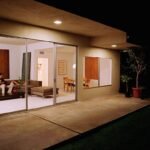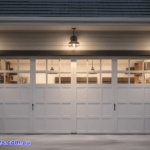
Timber French doors are a timeless architectural element that grace homes with elegance, natural warmth, and beauty. With their characteristic large glass panels surrounded by wide stiles and rails made of solid wood, these doors create an inviting transition between the indoors and outdoors.
Timber French doors have been popular for centuries thanks to their aesthetic appeal, versatility, and superior performance. This definitive guide looks at everything you need to know about timber French doors – from their history and evolution to styles, materials, manufacturing, installation, features, maintenance and more.
A Brief History of Timber French Doors
The origins of French doors can be traced back to 17th-century France, where large glass-panelled doors became a popular fixture in palaces and manor houses. The French doors opened onto ornate balconies and terraces, allowing easy transition between interior rooms and outdoor spaces.
French doors were essentially glazed patio doors consisting of multiple glass panes in each door. The design provided better ventilation and lighting indoors.
The style was named “French doors” or “French windows” in England. In North America, the French door style evolved into pocket doors.
Over time, French doors were increasingly fabricated out of timber. Wood French doors offered superior stability, durability, and thermal performance – making them a mainstream architectural element by the 19th century.
Today, timber French doors are a hallmark of classic elegance and sophisticated design in homes worldwide.
Key Benefits of Timber French Doors
Timber French doors offer unique advantages that make them a popular upscale choice:
- Visual Appeal: The handsome wood frames and large glass panels create an elegant focal point. Timber French doors come in various styles to complement any home décor.
- Durability: High-quality wood is resilient and can last decades with proper care and maintenance. Oak, spruce and mahogany are common solid timber choices.
- Energy Efficiency: Advanced weatherstripping and double/triple glazing enhance thermal performance. Timber is also a natural insulator.
- Acoustic Insulation: The timber absorbs sound better than aluminium and steel. French doors with enhanced acoustic seals dampen outside noise.
- Security: Multi-point locking systems and laminated glass provide protection. Some models have steel reinforcements.
- Customization: From size to wood type to colour and hardware, timber French doors offer extensive customization to match a home’s requirements.
Types of Timber for French Doors
Choosing the right timber is crucial to durability and performance. Here are some of the most common types of wood used for French doors:
Oak
Oak is a classic choice prized for its strength, hardness and attractive grain. White oak resists rotting, while red oak has a slightly more pronounced grain. Both are durable options.
Larch
Larch wood has a tight, interlocking grain that makes it resistant to warping. It offers the aesthetic appeal of oak at a lower cost.
Meranti
Meranti is a tropical Southeast Asian hardwood available at affordable prices. It offers varied grains and colours and can be easily treated, painted or varnished.
Spruce
Lightweight spruce wood provides an economical option for French doors. It stains well but lacks the hardness of oak.
Eucalyptus
Eucalyptus is naturally resistant to decay and moisture damage. When finished, it has an attractive figure and pale colouring.
Accoya
Accoya wood is created by modifying sustainably sourced softwood with acetic anhydride. This enhances durability and stability significantly.
Aluminum-Clad
Aluminium-clad timber cores combine the benefits of wood and aluminium. The timber provides stability, while aluminium cladding resists weathering.
French Door Design Elements

Beyond the choice of timber, French door design involves various elements:
Door Style
- Classic French: Traditional design with large glass panels surrounded by wide stiles and rails.
- French Casement: Outward opening doors fitted on hinges. Offer better ventilation.
- French Sliding: Doors slide horizontally to save space. Easy opening and closing.
Number of Door Leaves
- Single: One large door with two glass panes. Offers wide-open entrance.
- Double: Two equally-sized doors that meet in the middle. It’s the most common style.
- Asymmetrical: Two doors with unequal widths, usually a 1/3 and 2/3 configuration.
Glass
- Single Glazing: Single glass pane per sash. Basic thermal performance.
- Double Glazing: Two panes separated by a gas-filled cavity. Enhanced insulation.
- Triple Glazing: Three panes for maximum energy efficiency and noise reduction.
Panel Configuration
- Full View: Full glass panes without crossbars for unobstructed views.
- Half View: Horizontal or vertical crossbars divide each pane into halves.
- French Lite: Multiple smaller panes per sash surrounded by muntins. Timeless aesthetics.
- Arched: The upper portion of glass panes has an arched shape.
Hardware
Hardware enhances aesthetics, security and functionality:
- Handles and knobs: Come in a wide variety of styles and finishes.
- Multi-point locks: Provide enhanced security by locking multiple points. Key options available.
- Automatic locks: Lock doors simply by closing them. Motorized options, too.
- Hinges: Go for durable stainless steel or brass hinges for heavy doors.
- Weatherstripping: Prevents air leaks around doors. Choose high-compression foam strips.
Colour and Finish
Timber French doors can be factory-finished or painted/stained on-site:
- Factory Finishes: Offer consistent, durable results in many solid/translucent stains and opaque paint colours.
- Site Painting/Staining: Allows customization but requires proper prep and application for long-lasting results.
- Aluminium cladding: Powder-coated finishes in diverse hues. No need for repainting.
Manufacturing Excellence for Timber French Doors

Reputable manufacturers of timber French doors adhere to the highest standards of craftsmanship and quality:
- Responsible sourcing of timber from managed forests
- Kiln drying timber to optimal moisture content
- Precision computer-controlled machining for consistent sizing
- Advanced glazing with warm edge spacer bars
- Multi-stage factory finishing for durability
- Extensive quality testing and inspections
- Investing in R&D to integrate the latest innovations
- Providing extended warranties (10 years and beyond)
Buying from manufacturers who prioritise quality ensures your French doors will last for decades while providing optimal performance.
Seamless Installation
Proper installation is key to maximizing the benefits of timber French doors while making them blend seamlessly into your architecture.
Hiring a competent installer is highly recommended for French door projects, but DIY installation is also feasible if care is taken to follow all protocols.
Here is an overview of the timber French door installation process:
- Verify all measurements of the rough opening and order pre-hung doors for a perfect fit.
- Prepare the rough opening by ensuring it is plumb, level and square.
- Install exterior doors first, starting with the passive door. Fasten the hinges securely to the studs.
- Set proper clearances and shim as needed to prevent twisting or sagging.
- Double check reveals are even. Adjust strike plate placement accordingly.
- Caulk along edges for air sealing without restricting movement. Foam tapes also work.
- Extend exterior water barriers to seal the door perimeter. Add flashing above.
- Install handles, locks, weatherstripping and door sweeps as the final steps.
- Make final adjustments to ensure proper functioning before insulation and drywall.
With careful installation and finishing, your timber French doors will operate smoothly for maximum enjoyment.
Advanced Features and Options
Timber French door manufacturers offer advanced options and customization:
Enhanced Security
- Laminated and tempered glass for burglar resistance
- Reinforced stiles and locking systems on exterior doors
- Integrated alarm systems and access control via smart locks
Energy Efficiency
- Triple glazing with low-E coatings for insulation
- Thermally broken frames to prevent heat transfer
- Automatic door bottoms and advanced weatherstripping
Noise Reduction
- Advanced glass, seals, sweeps and automatic bottoms
- Solid core doors with perimeter acoustic seals
- Using different thicknesses of glass
Easy Access
- Smooth-rolling hardware for slide doors
- Automatic door openers and closers
- Low thresholds for wheelchair access
Motorization
- The electric operation allows doors to open via switches or automation
- Motorized screens for improved insect control
Smart Home Integration
- Smart lock systems with phone app control
- Integration with home automation systems
- Remote monitoring and operation
With cutting-edge options like these, timber French doors can be enhanced to provide superior luxury and performance.
Use Cases for Timber French Doors
The versatile design of timber French doors makes them suitable for varied residential and commercial settings:
Residential Use Cases
- As grand patio doors open onto decks, patios or gardens
- Indoor doors between living spaces like kitchens, dining rooms and sunrooms
- A closet or pantry doors that require ventilation
- In place of walls, create open, airy living spaces
- As striking architectural focal points in entryways and hallways
Commercial Use Cases
- In restaurants, café patios and hotel dining areas
- Separating office spaces, conference rooms and lobbies
- In retail stores, malls and boutiques for aesthetics and access
- In spas, gyms and studios to connect indoor/outdoor areas
Timber French doors allow endless possibilities for opening spaces and enhancing décor no matter the setting.
Maintaining Timber French Doors

Timber French doors will retain their beauty and function with routine care and maintenance for decades. Here are some tips for keeping them in top shape:
- Inspect door panels and hardware annually. Fix any loose parts immediately.
- Reseal perimeter seals and weatherstripping every 2-3 years to prevent air and water infiltration.
- Refinish exterior doors whenever the factory finish deteriorates. Spot touch-ups can work for minor damage.
- Clean glass only with approved glass cleaners. Never use abrasive products.
- Keep door tracks and hardware lubricated per manufacturer guidelines.
- Make sure drainage weep holes are clear of debris and obstructions.
- Check for product recalls and upgrades offered by manufacturers.
Protecting timber French doors from direct sun exposure and moisture is key to longevity. Follow the recommended care guidelines of your specific product model.
Expert Insights on Timber French Doors
Here are some insights on timber French doors from top designers and architects:
“Timber French doors are the ultimate way to infuse warmth while connecting indoor and outdoor living spaces seamlessly. The clean-lined design suits both traditional and contemporary homes.” – Sarah Richardson, Celebrity Designer
“I love using timber French doors instead of walls when laying out open floor plans. They let light permeate deeper into the home and can be easily personalized with stylish hardware.” – Joanna Gaines, Co-Founder of Magnolia Homes
“Timber offers unmatched stability and insulation for exterior doors. Modern enhancements like multi-point locks and low-E glass have made timber French doors better-performing than ever.” – Mike Holmes, Respected Contractor and TV Host
“The wow factor of timber French doors comes from the interplay of solid wood framing and transparent glass. Thoughtful design allows you to turn them into true architectural features.” – Ty Pennington, Designer and TV Personality
Latest Trends with Timber French Doors
Timber French doors remain a top choice for homeowners looking to elevate their interiors. Here are some of the latest trends:
- Oversized doors make a dramatic statement and maximize views
- Unfinished wood for a natural, organic aesthetic
- Matte black hardware for a bold, sophisticated look
- Mixed materials like timber with steel or fibreglass accents
- Non-traditional shapes like arcs and angles for modern homes
- Smart technology integration for convenience and security
- Creative use indoors as partitions between rooms
With limitless options for customization, timber French doors satisfy both traditional and contemporary design visions.
Frequently Asked Questions
What is the best wood for exterior French doors?
Oak and aluminium-clad timber are best for weather resistance. When properly finished, tropical hardwoods like mahogany also perform well.
Should French doors open in or out?
Outward-opening French casement doors allow better ventilation. Inward-opening doors occupy less exterior space. Choose based on your priorities.
How much do custom timber French doors cost?
They range from $1000 – $4000 for a standard-sized double door. Costs go up for premium woods, custom sizing, hardware upgrades and smart features.
How energy efficient are timber French doors?
Timber is a good insulator. With enhancements like multi-pane glazing and thermally broken frames, timber French doors can meet stringent insulation standards.
Do French doors provide adequate security?
Solid timber doors with multi-point locks, security hinges, reinforced frames and laminated glass offer perfect security. Technology integration enhances security further.
How Do Timber French Doors Maintain Their Timeless Appeal in Architecture?
Timber French doors maintain their timeless appeal in architecture due to the significant architectural impact of French doors. Their classic design and functionality seamlessly blend indoor and outdoor spaces, providing an elegant and sophisticated touch to any building. The natural beauty and versatility of timber enhance their enduring popularity in architectural designs.
Concluding Impressions: The Enduring Beauty and Functionality of Timber French Doors
With their enduring charm and sophistication, it is easy to see why timber French doors have been a fixture of luxury homes for centuries.
Thanks to advancements in manufacturing and innovative features, today’s timber French doors offer even more benefits like energy efficiency, security, durability, and customization potential.
Homeowners and industry professionals can leverage French timber doors to enhance residential and commercial spaces with elegance and practicality by understanding the nuances of design, material selection, installation, and maintenance covered in this guide.
I'm James Davis, a carpenter with eight years of experience in carpentry services, repairs, installations, renovations, and maintenance of interior doors. I have a diploma in carpentry and joiner trade from the Education Skills Australia Institute and take pride in delivering high-quality results to ensure customer satisfaction. I'm a blog writer for Octopus Doors Company and enjoy sharing my knowledge and tips on maintaining security measures and choosing the right door materials, paints, or handle styles. I specialize in custom-made interior doors and strive to make every home look fabulous. Contact me anytime for help with door-related issues.










